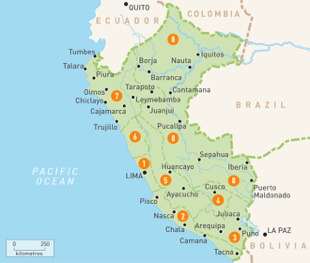April 6th, 2018

The Country
As a country, Peru has a deep rich history, dramatic and diverse landscapes, breathtaking architectural feats, incredible wildlife, and fascinating ancient culture. Peru is the third-largest country in South America. almost twice the size of Texas; slightly smaller than Alaska. Lima is the capital and largest city. Ancient Peru was the seat of several prominent Andean civilizations, most notably that of the Incas whose empire was captured by Spanish conquistadors in 1533. Peru declared its independence in 1821 and it’s government is a Presidential Republic.
Here are a few fun facts about the country:
1. There are 3 official languages in Peru: Spanish, Quechua and Aymara, but east of the Andes in Amazon jungle regions it is thought that natives speak 13 different indigenous languages.
2. The sacred city of Caral-Supe is said to the oldest residence of our ancestors as human beings in the Americas, and it is over 5,000 years old.

Interesting Facts About Peru: Sacred City of Caral-Supe. Photo by Christopher Kleihege
3. Peru’s Macchu Pichu was named one of the New Seven Wonders of the World in 2007, along with the Great Wall of China and the Taj Mahal.

4. The world has a population of 10 million Alpacas, but more than 3.5 million of them are found in Peru.

An Alpaca. It is a domesticated species of South American camelid. It resembles a small llama in appearance. Image credit – Wikipedia.org
5. There are over 3,000 different varieties of Potato grown in Peru. The potato is originally from Peru, and there are over 3,000 different varieties.

The Education System
In 1996, the government of Peru passed education reforms that extended free and compulsory school education to all students aged between 5 and 16, known as educación básica (general stream) y técnico productiva (technical).
6. Literacy rate is 94.2%
7. Education is offered at four main levels: Primary; Secondary; Vocational and Technical; and
University.
8. Public education is free
9. Private schools operate at all levels of the education system.
10. As mandated in a 2008 ministerial decree, schools in both the public and private sectors follow the national curriculum which is set at the federal level and overseen by local education authorities.
11. The academic school year starts at the beginning of March and runs through to November/ December.
12. The language of instruction is Spanish. In some regional primary schools, Aymara or Quechua is the language of instruction with Spanish offered as a second language.
13. The Ministry of Education is the authority overseeing all levels of education from preschool through higher education and sets all education policy, legislation and curriculum guidelines.

Ministry of Education, Peru
14. In January 2015, under the direction of the Minsitry of Education, January 2015, a new higher education authority, known as the Superintendencia Nacional de Educación Superior Universitaria (SUNEDU, National Superintendency of University Higher Education) was formed replacing the Asamblea Nacional de los Rectores (ANR, National Assembly of Rectors) with the goal to improve quality standards and approving university operating licenses.
Elementary and Secondary School education
15. The school system is 12 years in duration.
16. Pre-school education (educación inicial) begins age 5 is 1 year and is compulsory.
17. Primary school (educación primaria) is for ages 6-11 and is 6 years in duration.

18. Secondary school (educación secundaria) is for ages 12-16 and is 5 years in duration.
19. General secondary education is 2 years in duration.
20. Academic secondary covering arts or science tracks is 3 years in duration and follows after general secondary.
21. Technical secondary education (Educación Secundaria Diversificada) is offered at colegios secundarios con variante técnica and is 3 years in duration and follows after general secondary.
22. Students who graduate from secondary school receive the Certificado Oficial de Estudios de Educación Secundaria which qualifies them to sit for university entrance examinations.
Post-Secondary Technical Education
23. Most technical and vocational training at the postsecondary level is offered at the following: Institutos y Escuelas de Educación Superior Technológicos – IEST (higher institutes of technology); Institutos de Educación Superior Pedagógicos – IESP (higher institutes of teaching); Institutos y Escuelas Superiores de Educación de Formación Artística – IESFA (higher institutes of arts).
24. The Título de Experto – or – Título de Segunda y Ulterior Especialización Profesional are available options for further graduate-level training in a field of specialty in which the candidate has obtained prior qualifications.
25. Credits, courses or programs completed in the technical and vocational higher education sector cannot be transferred to university study.
Teacher Training
26. Teacher training programs of 5 years in duration are offer at higher institutes of pedagogy (IESP) leading to the title of Profesor and mention of the educational level and specialization completed.
27. Teacher-training programs are also offered at universities.
28. Training of teachers in technical education are provided by the institutos superiors tecnológicos which are three years in duration and lead to the award of the Título de Profesional Técnico.
Higher education
29. Higher education is offered mainly through the nation’s university system.
30. Peru’s National University of San Marcos, which was founded in the year 1551, is the oldest university in the Americas.

National University of San Marcos
31. Currently, there are currently 51 public (nacional) universities and 89 private (particulare) universities – both for-profit and non-profit – operating in Peru.
32. University-level institutions also include many specialized art, music and religious institutions that are called conservatorio, instituto, and escuela superior.
33. The academic year typically lasts 34-36 weeks and is divided into two semesters.
34. Courses are credit (créditos) weighted and start in late March or early April. A credit hour is equivalent to one hour (45-50 minutes) of instruction per week, or two hours of practical work per semester.
Undergraduate
35. The first two years of the academic degree of Bachiller requires general studies (estudios generals of at least 35 credits), followed by a period of specialization of three to five years (five to seven years total, minimum 200 credits).
36. Students who hold the Bachiller and are pursuing the professional title (Licenciado / Titulo Profesional) must complete an additional requirement which can either be a thesis, Six-month internship with a report or, in some cases, comprehensive examinations. The professional title is required in order to practice a profession in Peru.
Graduate
37. Admission to the graduate studies is based on a Bachiller or equivalent.
38. Graduate programs are typically two years in duration, require the defense of original research work and lead to the title of Grado deMaestro/Magister are typically two years in duration and require the defense of original research work.
39. The Titulo de Diplomado is a shorter one-year (24 credits) graduate certificate program.
40. Admission to a doctoral program requires a master’s degree which lasts a minimum of three years and requires the completion and defense of a dissertation. Successful candidates are awarded the Grado de Doctor.

At ACEI, we see the importance of international education in our global economy and strive to maintain the exchange and dissemination of information by assisting colleges and universities, professional organizations, and employers around the world with our research and credential evaluation services that help enhance their reputation and competitive recruiting effectiveness. To learn more about ACEI and its services such as Credential Evaluation, Translation, Webinars and Training, and how we can assist you with your credential evaluation and recruitment needs, please visit www.acei-global.org or call us at 310.275.3530.
Sources:
http://thefactfile.org/peru-facts/
https://alibi.com/blog/s/travel/31337/Fun-And-Not-So-Fun-Facts-About-Peru.html
https://www.huffingtonpost.com/entry/50-fun-facts-you-probably-never-knew-about-peru_us_58507beee4b0a464fad3e4b5
https://www.cia.gov/library/publications/the-world-factbook/geos/pe.html
Education system: Peru, NUFFIC, The Netherlands
Electronic Database on Global Education, Peru, American Association of Collegiate Registrars and Admissions Officers, Washington, DC www.aacrao.org
Online Guide to Educational Systems Around the World, Peru, NAFSAL Association of International Educators, Washington, DC www.nafsa.org





































